Sculptures by Wit Stoss. Figures by Durer. Rubens paintings. There were real masterpieces in pre-war Polish collections. During the war, many of them were stolen and taken away, mainly to Germany. Others were thoughtlessly destroyed. These are the most valuable lost treasures that have yet to be recovered.
It is hard not to think angrily that the turmoil of war has deprived us of priceless works. Among other things, the following disappeared:
10. Czerwińska antaba
It is well known that during the Second World War, the Germans massively removed sculptures and paintings from Poland. However, few people know that less obvious thefts were also committed. It turns out that the Nazis did not spare even the antab, or monastic knockers. One was their prey, and not just any. The door knocker, originally attached to the side door of the Romanesque church in Czerwińsk, was from the period between the 10th and 13th centuries. It is made of bronze. Such castings were a real rarity back then.
What is even more unusual for the crimes committed at that time, we know the perpetrator of this theft by name and surname. It was art history professor Dagobert Frey. The same one who personally supervised the dismantling of fireplaces at the Royal Castle in Warsaw. The Romanesque antaba never returned to Czerwińsk, and today it is probably in the hands of the professor's heirs.
9. "Saint Anna Samotrzecia from Tarnów", Wit Stwosz
The original location of the sculpture by Wit Stoss depicting Saint Anna Samotrzecia is unknown. She probably came to the Diocesan Museum in Tarnów, where she was last seen, from the Krakow collegiate church of St. Anne or from one of the chapels of St. Mary's Church. In 1940, the work was stolen by the Germans on the pretext of organizing an exhibition of works by Wit Stoss in Nuremberg, the sculptor's hometown.
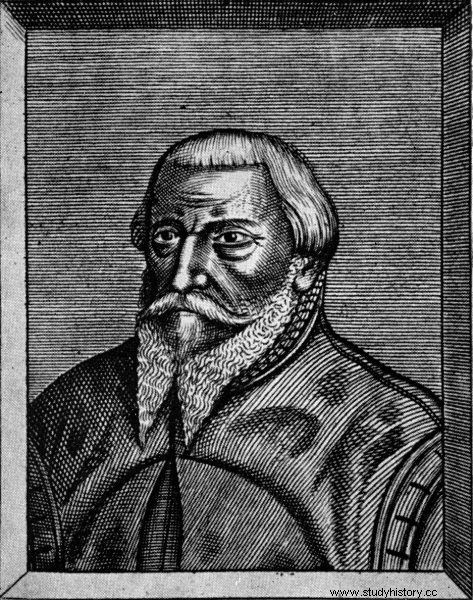
The Nazis took a special liking to the works of Wit Stwosz. The figure shows the image of the Master published in Die großen Deutschen im Bilde in 1936.
The sculpture of Anna Samotrzecia was not the only work of the master that was taken away from Poland. A similar fate befell the figures from the altar of St. Mary's Church, despite the fact that they were planned to be secured. Marta Grzywacz describes the intentions of protecting one of Krakow's greatest treasures in the book "Defender of the treasures":
The Society of Krakow History and Monuments Lovers decided in March 1938 to establish a committee to protect the Wit Stwosz altar in case of war. Karol Estreicher is not at the meeting then, he is in Stockholm, but everyone knows his opinion: St. Mary's altar should be evacuated . However, there are also other suggestions - maybe it is enough to just secure the vault of the temple? Or to build a shelter and lower sculptures into it with the help of lifts?
We managed to recover the figures right after the war. However, traces of the Tarnów sculpture have been lost. One can only wonder if if she were in the same transport, she would also return to Poland.
8. "Portrait of Fryderyk Chopin" by Ambroży Mieroszewski
"Portrait of Fryderyk Chopin" is one of the series of portraits of the entire Chopin family lost in the turmoil of the war. For a long time it seemed that finding them was almost a miracle. A breakthrough in the search came in October 1976. Maria Lewkowicz, an employee of the Society of During a lazy afternoon spent in front of the TV set by Fryderyk Chopin, she saw the image of the composer's sister, Izabella, on the TV screen. The precious painting turned out to be ... an element of the interior design of the heroes of the GDR film drama "Wedding every week."
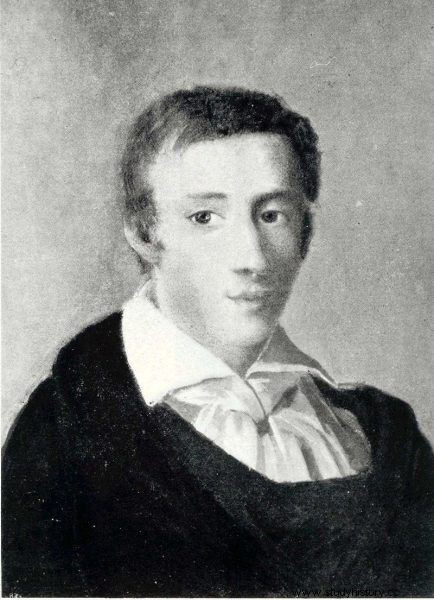
Did the portrait of Fryderyk Chopin appear in GDR series? The illustration shows the only surviving reproduction of the Composer's portrait painted by Ambroż Mieroszewski.
Soon after it came to light that the portraits of the representatives of the Chopin family are one of the favorite elements of the decor of GDR stage designers. In another film, a likeness of Frederic himself appeared on the wall. The German side still swears that only copies of the missing pictures were used in the films. Nevertheless, she has not yet decided to present them to Polish experts.
7. "Temptation of St. Anthony ”, Lucas Cranach the Elder
Woodcut depicting St. Antoni Pustelnik came from the collection of Jakub Kabrun, a well-known Gdańsk merchant and collector. At one time it was an exhibit from the collection of the City Museum in Gdańsk. During World War II, the graphics were taken to the city of Gotha in Lower Saxony, and from there - probably to the Soviet Union. And yet the saintly father Antoni warned: No one can enter the Kingdom of Heaven untested. Tempted by his image, the raiders did not seem to be victorious in their attempt.
6. "A hunting trip", Józef Brandt
The expressive work of the Polish historical painter Józef Brandt, a representative of the Munich school, probably shared the fate of other exhibits taken from the Silesian Museum in Katowice. After its liquidation, the collections were transported to the Landesmuseum in Bytom. Many of them were looted or destroyed, and the rest was deployed after the war in nearby monasteries and palaces.
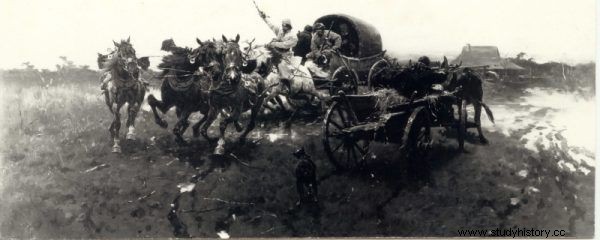
The painting of Józef Brandt, considered a representative of the Munich School, also became the target of the Nazis. The photo shows the lost work "A hunting trip".
The good news, however, is that we have managed to recover another work by this author, The Dangerous Passage. In the future, this painting is to be part of the permanent exhibition of Munich-style paintings at the Silesian Museum.
5. "King Stanisław August inspects the Warsaw Castle after the fire in 1765", Bernardo Belotto (Canaletto)
A fire saved from a fire - this is how the story of Canaletto's painting can be briefly presented. During the fire that broke out as a result of a bombing in early September 1939, the painting was transferred from the Royal Castle to the National Museum. Unfortunately, it was not the end of his journey. Museum exhibits were successively removed from there. First they went to Kraków, and then to the Reich.
To this day, it is not known what the further fate of Canaletto's painting was. One can guess, however, that he was not treated worse than those works of art that were left in the Museum. Monuments that were not taken away in advance were mostly burned down during the action of destroying Warsaw after the defeat of the 1944 uprising.
4. "Beautiful Madonna from Toruń"
The gothic statue of the Madonna made of limestone was reportedly seen after the war. German art historians sent timid signals to their Polish colleagues that it might be in one of the private collections near Bonn. For now, however, only one thing is certain:in the Church of Saint Johns in Toruń, only its base remains after the sculpture. Madonna, when there was no such thing. It should be added that the Nazi plunder did not prevent the inhabitants of Toruń from worshiping the lost image of the Blessed Virgin. The cult of the Toruń Madonna continues to this day.
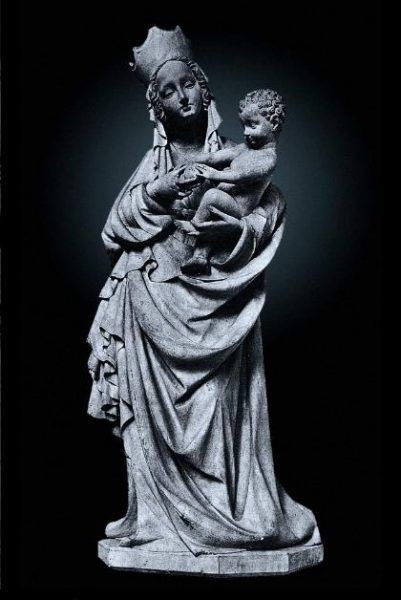
Where is the "Beautiful Madonna of Toruń" today?
3. "The Reclining Lioness" by Albrecht Dürer
"Lying Lioness" is one of the three drawings by a master of the German Renaissance that were lost during the war. Like many other works, this was also to enrich the collections of the Reich, probably as part of the exhibition at the museum in Linz. Unfortunately, "The Lying Lioness" did not make it to Linz. All leads end in Krakow.
Interestingly, the information that the engraving is no longer in Polish collections has not reached cultural researchers. . Until the end of the 1970s, requests from all over the world to borrow drawings for exhibitions were sent to the Print Room of the University of Warsaw Library. Including - ironically - from Germany.
2. "Christ falling under the cross", Peter Paul Rubens
Created at the beginning of the 17th century, Rubens' sketch "Christ Falling Under the Cross" found its way to Polish collections at the end of the 19th century. Before the war, it was recognized as one of the most valuable exhibits in the collection of the National Museum. No wonder that he quickly found his amateur among the Germans who robbed Polish collections. "Christ Falling at the Cross" is not the only one of the lost works of the most famous Flemish painters. Also waiting to be found is "Diana and Callisto", a sketch showing a scene from Ovid's "Metamorphoses".
1. "Portrait of a Young Man" by Rafael Santi
The portrait of a young man by the master Raphael himself was created in the early 16th century. Finding it is perhaps one of the most anticipated successes in the painstaking process of recovering works stolen during World War II. For years, in the Czartoryski Museum in Kraków, there was even an original picture frame with a photograph of a lost work in it. Meanwhile, although in the mid-1980s, thanks to a mysterious American, there was a shadow of hope for finding the painting, to this day, it has not been possible to determine his whereabouts.
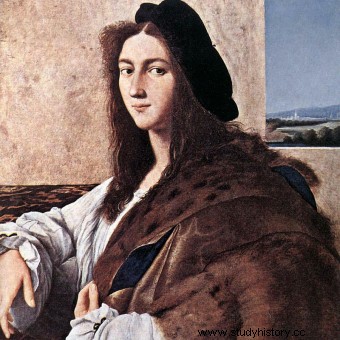
What happened to Rafael Santi's Portrait of a Young Man?
The search continues. The "Portrait of a Young Man" is remembered not only by Krakow museum experts. It is also not forgotten by… fans of popular culture. The theme of the loss of the painting appeared in one of the most famous Polish crime novels of recent years.
